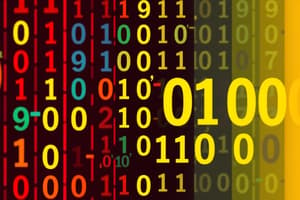Podcast
Questions and Answers
What is the weight of the rightmost digit in a binary number?
What is the weight of the rightmost digit in a binary number?
- $2^{-1}$
- $2^1$
- $2^{-2}$
- $2^0$ (correct)
How many bits are in a byte?
How many bits are in a byte?
- 4
- 2
- 8 (correct)
- 16
What is the value of the binary number 101.01 in decimal?
What is the value of the binary number 101.01 in decimal?
- 5.25
- 6.00
- 5.50
- 5.75 (correct)
What is the value of the octal number 7562 in decimal?
What is the value of the octal number 7562 in decimal?
How many digits are there in the hexadecimal number system?
How many digits are there in the hexadecimal number system?
How can octal numbers be converted to binary?
How can octal numbers be converted to binary?
What is the radix of decimal numbers?
What is the radix of decimal numbers?
Which weighted number system starts from 100 = 1 and increases from right to left?
Which weighted number system starts from 100 = 1 and increases from right to left?
What is the base or radix of the binary number system?
What is the base or radix of the binary number system?
Which number system uses symbols 0-7?
Which number system uses symbols 0-7?
What type of code is ASCII?
What type of code is ASCII?
What is the weight assigned to the rightmost digit in a decimal integer number?
What is the weight assigned to the rightmost digit in a decimal integer number?
What type of code is ASCII?
What type of code is ASCII?
How many characters were encoded in the original ASCII using 7 bits?
How many characters were encoded in the original ASCII using 7 bits?
When was extended ASCII introduced and what was its character set size?
When was extended ASCII introduced and what was its character set size?
What is the purpose of the first 32 characters in ASCII?
What is the purpose of the first 32 characters in ASCII?
What did IBM introduce in 1981 related to ASCII?
What did IBM introduce in 1981 related to ASCII?
What is the purpose of extended ASCII?
What is the purpose of extended ASCII?
Flashcards are hidden until you start studying
Study Notes
Binary Number System
- The rightmost digit in a binary number has a weight of 1.
- A byte consists of 8 bits.
- The decimal equivalent of the binary number 101.01 is 5.25.
Octal Number System
- The decimal value of the octal number 7562 is 3962.
- Octal numbers utilize digits from 0 to 7.
- Octal to binary conversion can be achieved by replacing each octal digit with its corresponding 3-bit binary representation.
Number System Basics
- The radix of decimal numbers is 10.
- The binary number system has a base of 2.
- The weighted number system that starts from 100 = 1 and increases from right to left is known as binary.
ASCII Encoding
- ASCII is a character encoding standard that uses 7 bits for encoding.
- The original ASCII encoded 128 characters.
- Extended ASCII was introduced to accommodate 256 characters (including the original 128) to support additional symbols and characters.
- The first 32 characters in ASCII are non-printable control characters used for text formatting and control tasks.
- In 1981, IBM introduced PCs using ASCII, which helped standardize character encoding across computers.
- The purpose of extended ASCII is to provide additional characters for various languages and graphical representations.
Studying That Suits You
Use AI to generate personalized quizzes and flashcards to suit your learning preferences.




